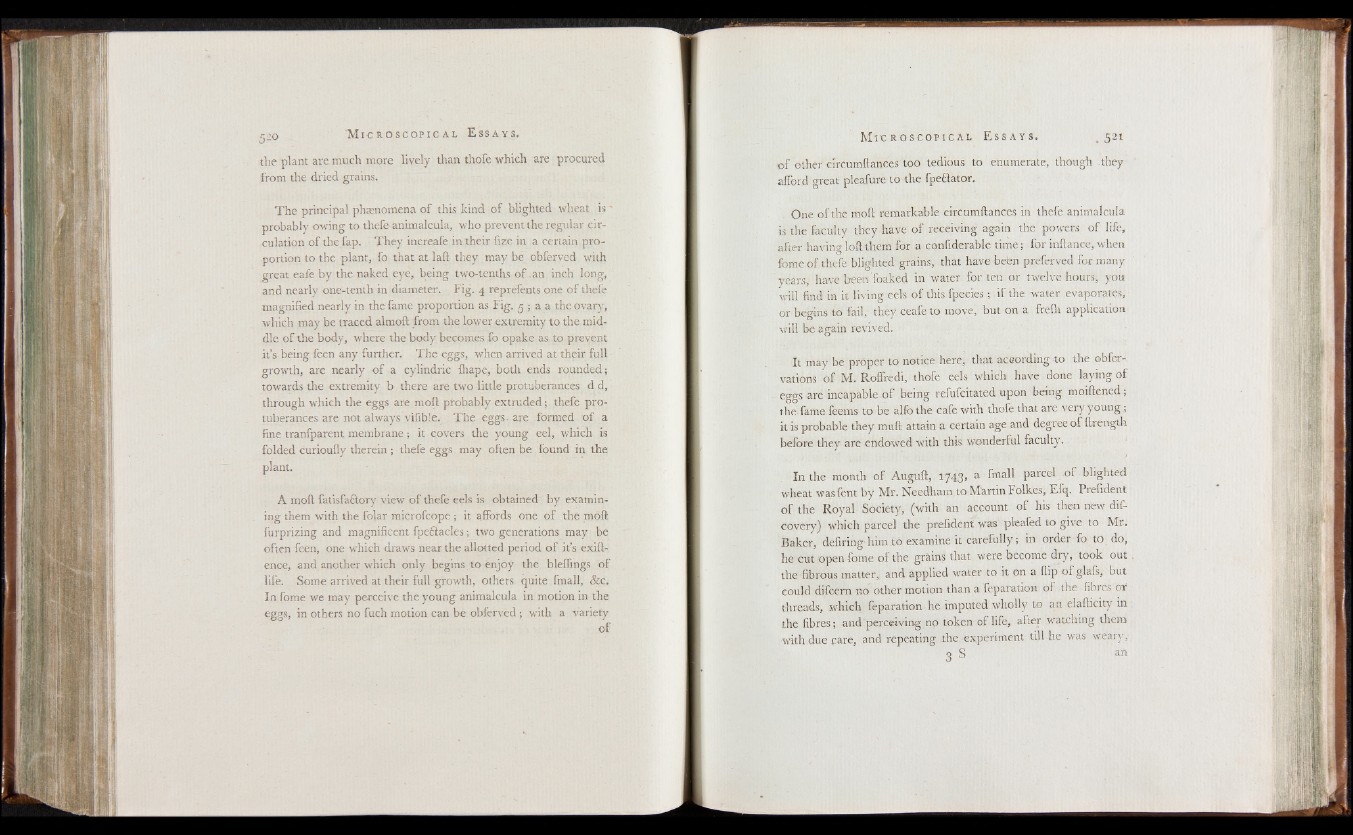
the plant are much more lively than thofe which are procured
From the dried grains.
The principal phenomena o f this kind of blighted wheat is -
probably owing to thefe animalcula, who prevent the regular circulation
of the fap. They increafe in their fize in a certain proportion
to the plant, fo that at laft they may be obferved with
great eafe by the naked eye, being two-tenths o f ,an inch long,
and nearly one-tenth in diameter. Fig. 4 reprefents one of thefe
magnified nearly in the fame proportion as Fig. 5 ; a a the ovary,
which may be traced almoft from the lower extremity to the middle
of the body, where the body becomes fo opake as to prevent
it’s being feen any further. The eggs, when arrived at their full
growth, are nearly o f a cylindric lhape, both ends rounded;
towards the extremity b there are two little protuberances d d,
through which the eggs are moll probably extruded; thefe protuberances
are not always yifib'e. The eggs, are formed o f a
fine tranfparent membrane ; it covers the young eel, which is
folded curioufly therein ; thefe eggs may often be found in the
plant.
A moll fatisfaftory view of thefe eels is obtained by examining
them with the folar microfcope ; it affords one of the moll
furprizing and magnificent fpeclacles; two generations may be
often feen, one which draws near the allotted period of it’s exift-
ence, and another which only begins to enjoy the bleffmgs of
life. Some arrived at their full growth, others quite fmall, &c.
In feme we may perceive the young animalcula in motion in the
eggs, in others no fuch motion can be obferved ; with a variety
o f
of other clrcumftances too tedious to enumerate, though they
afford great pleafure to the fpeftator.
One of the moll remarkable circumftances in thefe animalcula
is the faculty they have o f receiving again the powers o f life,
after having loft them for a confiderable time; for inftance, when
fome of thefe blighted grains, that have beta preferved for many
years, have been foaked in water for ten or twelve hours, you
will find in it living eels of thisfpecies; if the water evaporates, -
or begins to fail, they ceafeto move, but on a frelh application
will be again revived.
It may be proper to notice here, that aceording to the qbfer-
vations of M. Roffredi, thofe eels which have done laying of
eggs are incapable of being refufcitated upon being moiftened;
the- fame feems to be alio the cafe with thofe that are very young;
it is probable they mad attain a certain age and degree of ftrength
before they are endowed with this wonderful faculty..
In the month of Auguft, 174 3 , a fmall parcel of blighted
wheat was fent by Mr. Needham to M'artinFolkes; Efq. Prefident
of the Royal Society, (with an account of his then new discovery^
which parcel the prefident was pleafed to give to Mr.
Baker, defiring'him to examine it carefully; in order fo to do,
he: cut open fome of the grains that were become dry, took out
the fibrous matter, and applied water to it on a flip of glafs, but
could difcern no other motion than a reparation of the fibres or
threads, which feparation he imputed wholly to an elafticity in
the fibres; and'perceiving no token of life, after watching them
with due care, and repeating the experiment till he was weary,
3 S '